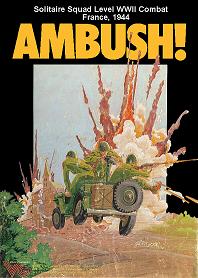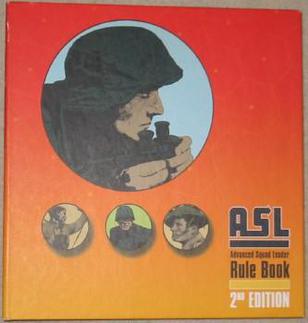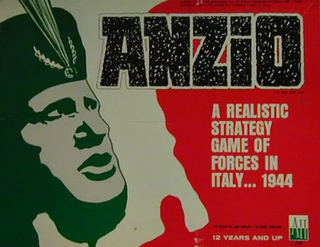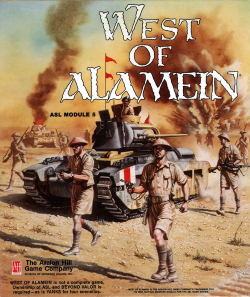Official Scenarios
| Game | # | Name | Allies | Axis | Date | Location |
|---|---|---|---|---|---|---|
| SL | 1 | The Guards Counterattack | | | 6 October 1942 | Stalingrad, USSR |
| SL | 2 | The Tractor Works | | | 6 October 1942 | Stalingrad, USSR |
| SL | 3 | The Streets of Stalingrad | | | 6 October 1942 | Stalingrad, USSR |
| SL | 4 | The Hedgehog of Piepsk | | | 14 November 1941 | Piersk, USSR |
| SL | 5 | Hill 621 | | | 1 July 1944 | near Minsk, USSR |
| SL | 6 | Escape From Velikiye Luki | | | 12 January 1943 | Velikiye Luki, USSR |
| SL | 7 | Buchholz Station | | | 16 December 1944 | Buchholz, Germany |
| SL | 8 | The Bitche Salient | | | 14 January 1945 | Bitche, Germany |
| SL | 9 | The Cannes Strongpoint | | | 23 August 1944 | Cannes, France |
| SL | 10 | Hitdorf on the Rhine | | | 6 April 1945 | Hitdorf, Germany |
| SL | 11 | The St. Goar Assault | | | 24 March 1945 | St Goar, Germany |
| SL | 12 | The Road to Wiltz | | | 17 December 1944 | Wiltz, Luxembourg |
| COI | 13 | The Capture of Balta | | | 3 August 1941 | Balta, Ukraine |
| COI | 14 | The Paw of the Tiger | | | 12 January 1943 | South of Leningrad, USSR |
| COI | 15 | Hube's Pocket | | | 6 April 1944 | near Buchach, USSR |
| COI | 16 | Sowchos 79 | | | 8 December 1942 | Chir River Line, Russia |
| COI | 17 | Debacle at Korosten | | | 30 August 1941 | Korosten, Ukraine |
| COI | 18 | The Defense of Luga | | | 19 July 1941 | Luga, USSR |
| COI | 19 | A Winter Melee | | | 17 February 1942 | Okorovo, Russia |
| COI | 20 | Breakout From Borisov | | | 2 July 1941 | Borisov, Russia |
| COD | 21 | Battle for the Warta Line | | | 6 September 1939 | Central Poland |
| COD | 22 | The Borders are Burning | | | 30 November 1939 | Kuhmo, Finland |
| COD | 23 | Silent Death | | | 9 December 1939 | Aittojoki, Finland |
| COD | 24 | Action at Balberkamp | | | 22 April 1940 | Balberkamp, Norway |
| COD | 25 | Resistance at Chabrehez | | | 10 May 1940 | Chabrehez, Belgium |
| COD | 26 | Assault on a Queen | | | 11 May 1940 | The Hague, Netherlands |
| COD | 27 | The Dinant Bridgehead | | | 13 May 1940 | Houx, Belgium |
| COD | 28 | Counterstroke at Stonne | | | 15 May 1940 | Stonne, France |
| COD | 29 | In Rommel's Wake | | | 17 May 1940 | on the Meuse, France |
| COD | 30 | Ad Hoc at Beaurains | | | 21 May 1940 | Arras, France |
| COD | 31 | Chateau de Quesnoy | | | 6 June 1940 | Le Quesnoy, France |
| COD | 32 | Rehearsal for Crete | | | 26 April 1941 | Peloponnesus, Greece |
| GI | 33 | A Belated Christmas | | | 27 December 1944 | Bastogne, Belgium |
| GI | 34 | Climax at Nijmegen Bridge | | | 20 September 1944 | Nijmegen, Netherlands |
| GI | 35 | The French Decide to Fight | | | 10 November 1942 | Port-Lyautey, Morocco |
| GI | 36 | Weissenhof Crossroads | | | 16 December 1944 | Schnee Eifel, Germany |
| GI | 37 | Medal of Honor | | | 21 September 1944 | Nijmegen, Netherlands |
| GI | 38 | The Factory | | | 11 February 1944 | Aprilia Settlement, Italy |
| GI | 39 | Sweep For Bordj Toum Bridge | | | 10 December 1942 | Bordj Toum Station, Tunisia |
| GI | 40 | The Dornot Watermark | | | 10 September 1944 | Dornot, Germany |
| GI | 41 | Swatting at Tigers | | | 11 July 1943 | Biazzo Ridge, Italy |
| GI | 42 | Bridgehead on the Rhine | | | 24 March 1945 | Speldrop, Germany |
| GI | 43 | Action at Kommerscheidt | | | 4 November 1944 | Kommerscheidt, Germany |
| GI | 44 | Prelude to Breakout | | | 7 July 1944 | Vire et Taute Canal, France |
| GI | 45 | Hide and Seek | | | 7 June 1944 | Normandy, France |
| GI | 46 | Operation Varsity | | | 24 March 1945 | near Hamminkeln, Germany |
| GI | 47 | Encircling the Ruhr | | | 30 March 1945 | the Ruhr, Germany |
Other official Scenarios (Avalon Hill)
Series 100
Avalon Hill released Series 100, ten new Scenarios for Cross of Iron, in 1979. The Scenarios were designed by Courtney Allen (SL playtester and designer of Storm Over Arnhem ).
| # | Title | Allies | Axis | Date | Location |
|---|---|---|---|---|---|
| 101 | Blocking Action at Lipki | | | 3 July 1941 | near Borisov, USSR |
| 102 | Slamming of the Door | | | 17 August 1941 | Panikovo forest, USSR |
| 103 | Bald Hill | | | 11 September 1941 | Leningrad, USSR |
| 104 | The Penetration of Rostov | | | 24 July 1942 | Rostov, USSR |
| 105 | Night Battle at Noromatyevka | | | 1 January 1943 | Noromaryevka, USSR |
| 106 | Beachhead at Ozereyka Bay | | | 4 February 1943 | Ozereyka valley, USSR |
| 107 | Disaster On The Dneiper Loop | | | 24 September 1943 | Dnieper River, USSR |
| 108 | Block Busting in Bokruisk | | | 29 June 1944 | Bokruisk, USSR |
| 109 | Counterattack On The Vistula | | | 6 August 1944 | near Wola Chodkowska, Poland |
| 110 | The Agony of Doom | | | 19 April 1945 | Muncheberg, Germany |
Series 200
Avalon Hill released Series 200 with 10 new Scenarios for Crescendo of Doom.
| # | Title | Allies | Axis | Date | Location |
|---|---|---|---|---|---|
| 201 | Sacrifice Of Polish Armor | | | 1 September 1939 | Novy Targ region, Poland |
| 202 | Under Cover Of Darkness | | | 12 September 1939 | Gdynia, Poland |
| 203 | Bitter Defense At Otta | | | 28 April 1940 | Gudbrandsal valley, Norway |
| 204 | Chance D'une Affaire | | | 14 May 1940 | Chehery, France |
| 205 | Last Defense Line | | | 15 May 1940 | Bouvellemont, France |
| 206 | Fighting At The World's Edge | | | 28 May 1940 | Tarladsvikfjell, Norway |
| 207 | The French Perimeter | | | 2 June 1940 | Spyckar, France |
| 208 | Road To Kozani Pass | | | 13 April 1941 | Komanos, Greece |
| 209 | The Akroiri Peninsula Defense | | | 20 May 1941 | Profitilias, Crete |
| 210 | Commando Raid At Dieppe | | | 18 August 1942 | Varengeville, France |
Rogue Series 200
The Rogue Scenarios Series 200, named because they used boards 9, 10 and 11 which were not "official" boards at the time, used rules from the Crescendo of Doom. Some of the Scenarios needed multiple copies of several boards.
| # | Title | Allies | Axis | Date | Location |
|---|---|---|---|---|---|
| R211 | Auld Lang Syne | | | 1 January 1945 | Gerimont, France |
| R212 | On The Road To Andalsnes | | | 24 April 1940 | near Andalsnes, Norway |
| R213 | Traverse Right...FIRE! | | | 23 June 1941 | S of Bialystok, Poland |
| R214 | The Front In Flames | | | 22 August 1943 | S of Kharkov, USSR |
| R215 | Hasty Pudding | | | 27 May 1940 | near Dunkirk, France |
| R216 | A Small Town In Germany | | | 8 April 1945 | Friesoythe, Germany |
| R217 | The Whirlwind | | | 18 April 1945 | Aschaffenburg, Germany |
| R218 | Operation Switchback | | | 6 October 1944 | Scheldt estuary, Holland |
| R219 | Scheldt Fortress South | | | 25 October 1944 | Scheldt estuary, Holland |
| R220 | Clearing the Breskens Pocket | | | 6 October 1944 | Scheldt estuary, Holland |
| R221 | Vitality I | | | 24 October 1944 | South Beveland, Holland |
| R222 | Infatuate II | | | 1 November 1944 | Westkapelle, Walcheren Island, Holland |
| R223 | Night Drop | | | 6 June 1944 | Cherbourg Peninsula, France |
Series 300
Avalon Hill released Series 300 with additional Scenarios for GI: Anvil of Victory.
| # | Title | Allies | Axis | Date | Location |
|---|---|---|---|---|---|
| 300 | Trial by Combat | | | 27 February 1945 | Elsdrof, Germany |
| 301 | The Clearing | | | 10 October 1944 | Huertgen Forest, Germany |
| 302 | Stand Fast | | | 10 December 1944 | Obergeich, Germany |
| 303 | Thrust and Parry | | | 15 March 1945 | Pfaffenheck, Germany |
| 304 | Riposte | | | 15 March 1945 | Pfaffenheck, Germany |
| 305 | The Duel | | | 15 March 1945 | Pfaffenheck, Germany |
| 306 | The Rag Tag Circus | | | 12 April 1945 | Barby on the Elbe, Germany |
| 307 | Point D'Appui | | | 9 October 1944 | Bardebberg, Germany |
| 308 | Han-Sur-Neid | | | 11 November 1944 | Han-sur-Neid, France |
| 309 | The Roer Bridgehead | | | 23 February 1945 | Koerrenzig, Germany |
The General Magazine
Over the years, Avalon Hill also released Scenarios in issues of their magazine The General.
| # | ID | Title | Allies | Axis | Date | Location |
|---|---|---|---|---|---|---|
| 15–6 | A | Burzevo | | | 2 December 1941 | Burzevo, USSR |
| 15–6 | B | Hill 253.5 | | | 9 July 1943 | North of Kursk, USSR |
| 15–6 | C | The Burkin Bridgehead | | | 24 September 1943 | SE of Kiev, Ukraine |
| 15–6 | D | Delaying Action | | | 30 October 1944 | Western Lithuania |
| 17–2 | E | The Niscemi-Biscari Highway | | | 10 July 1943 | Biscari, Sicily |
| 17–2 | F | The Pouppeville Exit | | | 6 June 1944 | Normandy, France |
| 17–2 | G | Devil's Hill | | | 19 September 1944 | Kleve-Nijmegen, Holland |
| 17–2 | H | The Attempt to Relieve Peiper | | | 21 December 1944 | the Ardennes, Belgium |
| 17–2 | I | Hunters from the Sky | | | 24 March 1945 | Rhine river, Germany |
| 18–2 | J | Semper Paratus | | | 27 September 1944 | Oorderen, Holland |
| 18–3 | K | Fast Heinz | | | 7 August 1944 | Roslayl, USSR |
| 18–4 | L | The Long Road | | | 16 September 1942 | S of Andriba, Madagascar |
| 18–5 | M | The Dead of Winter | | | 29 December 1941 | NW of Staritsa, Russia |
| 19–5 | TS1 | First Crisis at Army Group North | | | 25 June 1941 | Daugav river, USSR |
| 19–5 | TS2 | Pavlov's House | | | 20 October 1942 | Stalingrad, USSR |
| 19–5 | TS3 | Land Leviathans | | | 3 July 1941 | Lipki, USSR |
| 19–5 | TS4 | Soldiers of Destruction | | | 10 October 1944 | Radzymin, Poland |
| 19–6 | N | Faugh A'Ballagh! | | | 16 May 1944 | Sinagoga, Italy |
| 20–2 | 1000 | Operation Marston | | | 14 July 1943 | Catania, Sicily |
| 20–4 | O | Strayer's Strays | | | 6 June 1944 | Normandy, France |
| 20–6 | SSTK 1a | Death's Head at Lusho | | | 24 September 1941 | Lusho, USSR |
| 20–6 | SSTK 1b | Death's Head at Lusho | | | 24 September 1941 | Lusho, USSR |
| 21–2 | P | Aachen's Pall | | | 25 October 1944 | Aachen, Germany |
| 21–3 | Q | Gambit | | | 21 May 1941 | Maleme, Crete |
| 21–4 | 2000 | Operation Hubertus | | | 11 November 1942 | Stalingrad, USSR |
| 22–5 | 3000 | Assault on Round Top | | | 30 September 1944 | north of Riga, Latvia |
ASL Annual
The final "official" Scenarios issued by Avalon Hill for the original Squad Leader game were in the first two issues of the ASL Annual.
| Issue | # | Title | Allies | Axis | Date | Location |
|---|---|---|---|---|---|---|
| ASL Annual '89 | A1 | On the Borderline | | | 30 November 1939 | Artahuhta, Finland |
| ASL Annual '89 | A2 | Sbeitla Probe | | | 17 February 1943 | Sbeitla, Tunisia |
| ASL Annual '89 | A3 | Regalbuto Ridge | | | 31 July 1943 | Regalbuto, Italy |
| ASL Annual '90 | A4 | King's Castle | | | 26 November 1944 | Frenzenberg, Germany |
| ASL Annual '90 | A5 | The Professionals | | | 7 April 1941 | Pirot, Yugoslavia |
| ASL Annual '90 | A6 | A Meeting of Patrols | | | 26 December 1944 | Hofen, Belgium |
| ASL Annual '92 | ACG | Commando Campaign Game | | |
All official Squad Leader Scenarios printed by Avalon Hill have been reissued for Advanced Squad Leader and released in either The General, ASL Annuals, or scenario packs. The ASL Journal had released seven Scenarios for Squad Leader but Multi-Man Publishing has indicated no intention to support the original SL game system.
Non-official scenarios
The Wargamer also released Scenarios 81–90 and a pack with Scenarios 91–100 in 1982. These were designed by contributors.
| Scenario 81 | A Bridge Too Near |
| Scenario 82 | To Lose A Battle |
| Scenario 83 | The Final Attempt |
| Scenario 84 | Le Paradis |
| Scenario 85 | The Far Bank |
| Scenario 86 | Raid on Vaagso |
| Scenario 87 | The Bruneval Raid |
| Scenario 88 | The Backwater of War |
| Scenario 89 | Cherkasskoye |
| Scenario 90 | The Bridge at Kanev |
| Scenario 91 | Assault At Wadelincourt |
| Scenario 92 | Patton's End Run |
| Scenario 93 | Cassino Station |
| Scenario 94 | Hill 112 |
| Scenario 95 | The Attempt To Exploit |
| Scenario 96 | Scratch Force |
| Scenario 97 | The Breaking Wave |
| Scenario 98 | Night Assault |
| Scenario 99 | Cooperative Venture |
| Scenario 100 | A Day At The Races |











